
63 Commissariat
63 Commissariat, once a turn of the century family home, located in the midst of Old Karachi, behind the arterial M.A. Jinnah Road, the building embodies an eccentric history. Whilst its beautiful baby-blue façade, and large windows speaks of its original architectural context, it was then purchased by the Pagganwala family in the 1970s, used as a milk factory under Mas Dairies, and subsequently a manufacturing plant for Glacier Mineral Water in the 1990s, as well as an office. Its unique narrative as a building creates an idiosyncratic venue for contemporary art, encouraging artists to interact organically with such a singular space.
Participating Artists:
Talal Faisal
Born in 1992 in Karachi (Pakistan)
Lives and works in Lahore (Pakistan)
Talal Faisal is an emerging artist based in Lahore. He received his early education at Aitchison College, Lahore and then graduated with honors from the School of Visual Arts at Beaconhouse National University, Lahore in 2016. He has taken part in group exhibitions in Karachi.
Talal Faisal has two works on view at KB17. In one he has constructed toys from wheat, speaking to the recent proliferation of Chinese-made soft toys in the markets and roadside stalls of Pakistan. In this installation, the artist wishes to address the successive legacies of British, American and Chinese influence in his country. He writes: “Chinese toys displayed in wheat is a satirical take on the dominance of a superpower on a Third World agrarian economy already battling with food insecurity. Wheat is an important signifier in this case.”

One Belt, One Road, 2017.
Mixed media installation
Dimensions variable
Courtesy the artist
Carla Chan
Born in 1989 in Guangdong (China)
Lives and works between Hong Kong and Berlin (Germany)
Carla Chan obtained her Bachelor of Arts Degree from the School of Creative Media, City University of Hong Kong. She works with a variety of media including video, installation, photography and interactive media. Much like the never-ending development of new technology Chan considers media art as a medium with infinite possibilities for artistic expressions. Minimal in style and form, Chan’s works often toys with the blurred boundaries between reality and illusion, figure and abstraction. Her recent work focuses on the ambiguity in nature. Bridging natural transformation and unpredictable computer algorithms, her work is consolidated with a cohesive dynamic between form, means and content. Her works have been showcased extensively in different International exhibitions. Including Punto y Raya festival in ZKM (DE), ISEA 2016 (HK), Hek (Haus der elektronischen Künste Basel) (CH), shortlisted in The Lumen Prize and Discovery LOOP Barcelona video Art Award, 2016 and Work selected in Hong Kong Contemporary Art Awards 2012 in Hong Kong Museum of Art. Recently, she won the Sponsorship prize from Minister of Arts in SAXON STATE in Germany and is preparing her solo exhibition at Sexauer Gallery in Berlin and Den Frie Contemporary Art Center in Copenhagen.
Carla Chan writes of Black Moves, on view at KB17: “[This] is a video that creates a spatial drama and a virtual landscape that simulates the forming and de-forming of an amorphous black mass, an evocative sensorial unfolding that traverses between the boundaries of the physical and the psychological as experienced inside a dark space. The multi-layered visuals in the video are created with a set of noise-generation algorithms simulating organic formations and patterns found in nature. These noise-like organic visual crystals are my attempts in naturalizing digital imageries via the creation of a virtual landscape. BLACK MOVES springs from my long obsession and fascination with natural transformations, particularly formless shapes and their movement. The transformative power of natural substances such as water, rock, air and clouds produce infinite varying forms that seem both ordered and random at the same time. These magical transformations continuously disorient and fascinate the senses, creating a rich perceptual journey that is chartered for a mysterious unknown cosmic. This unknown cosmic can be seen as a representation of an external world as well as a mirror of the psyche from within, where the immanent and the transcendent are fused as one via the ever-changing audiovisuality.”

Still from Black Moves, 2016.
Video installation, 9:30 min.
Courtesy the artist.
Vera Herr
Born in 1988 in Freiburg im Breisgau (Germany)
Lives and works in Berlin (Germany)
Vera Herr is a German filmmaker and video artist. Currently, she works as a freelance editor and artist in Berlin and Brussels. Herr works at the intersection of experimental, documentary and fictional films, presented as single screens or shown in the context of an installation. Her films have been shown internationally at film festivals, including EMAF, European Media Art Festival in Osnabrück, and KuFF 'Kumu Art Film Festival' in Tallin. She obtained her M.A. in AudioVisual Arts at the SintLukas School of Arts in Brussels. Her B.A. graduation project “Swimming Nude” won the Department Prize and got an honourable mention at the Royal Academy of Arts in The Hague (NL) in 2013. In 2011, she lived and studied for one year in Jerusalem at the Bezalel Academy of Arts and Design.
Of her work on view at KB17, Vera Herr sates: “The film director accompanies the person in front of the camera through the forgotten corridors of their personality. The ‘Scream Test’ reveals a prehistoric instinct and innate experience through the performer's body. The scream is a personal release: it actualizes the presence of aggression, touching upon the dimension of collective fear. Its high pitch abruptly interrupts the routine course of daily life. Provoking instant and total mental absorption, the scream paradoxically brings us back to reality, to the current time of now, as if a needle stung the collective body, exposing the limits of personal space and the shared sense of togetherness. What happens when the chroma key greenscreen meets the psychotherapy session?”

Still from Scream Test, 2015.
Experimental Short Film, HD 1920x1080, 16:9, color, BE, 18:45 min.
Courtesy the artist
Nadia Batool Hussain with Fatima Hussain
Fatima Hussain (b. 1983, Lahore) is an Artist-Curator/Theatre Practitioner based in Islamabad who teaches at the National College of Arts, Rawalpindi & Lahore campus. Fatima has presented projects at the Shanakht Festival Karachi; Flux Deptford X, SPILL Festival 2011 (London); Zahoorul Akhlaq Gallery, Lahore; Aicon Gallery London; The Guild NY; SAVAC, University of Toronto, and many others. Her work over the last few years has addressed multiple issues bringing into it the political, the historical, the everyday, and whether with intention or escape, ‘art’ for her, has fallen within a larger interpretation of the colonized structures, languages and territory. Fatima is a 2005 graduate of NCA (Lahore campus) where she was trained as a painter. She moved on to Central Saint Martins, UAL for her MA in Fine Arts (2007- 2008). Nadia Batool Hussain (b. 1978, Karachi) is a visual artist and art educator living and working in Islamabad/Rawalpindi. Her work is usually focused on the experience of the body, which she uses to identify the world around her. She collaborates with other artists and is focused on facilitating art practice in her community. She is currently teaching painting at the National College of Art, Rawalpindi Campus where she heads the Department of Fine Arts. Her work is an attempt to understand issues of identity and femininity in her experience. It usually focuses on narratives representing her experiences. The images and text tend to sway from the purely clinical and anatomical to something more emotional. She believes she can draw parallels between these two opposing notions by using one to identify the other.
For KB17 Nadia Batool Hussain and Fatima Hussain have collaborated on a site-specific installation entitled Correspondence. The artists write: “In response to ‘wit-ness’, the correspondence of the structure of Narayan Jagannath Vidyala High School works as the witness to the event, which in this case is the development of its surroundings. Our project takes the building as an entity that we imagine has corresponded across geographic terrains with other structures. We see this correspondence in today’s time as a witness to many events and developments even such that it finds difficult to articulate. Translation and interpretation of this correspondence (although fictive) unearths a sequence of events that reference the larger sociopolitical narrative of the region. These documents are layered with footnotes and musings of a discoverer who navigates through the letters in order to make sense of how the structure has witnessed its surroundings over time.”

Correspondence, 2017.
Installation
Dimensions variable
Courtesy the artists
Sohail Zuberi
Born in 1970 in Karachi (Pakistan)
Lives and works in Karachi (Pakistan)
Sohail Zuberi is a graphic designer, photographer and visual artist based in Karachi. He graduated from the Karachi School of Art in 1992. Along with his independent practice, Zuberi has been associated with academia for the past sixteen years. He was the head of the Communication Design department at the Indus Valley School of Art and Architecture 2012-2015, and has taught design, fine art and photography at the University of Karachi and the Textile Institute of Pakistan. Zuberi is also a former trustee of Vasl Artists’ Collective. Currently, he is a core team member of Numaish-Karachi, an interdisciplinary art collective, and serves on the board of Pakistan Chowk Cultural Centre, Karachi.
Sohail Zuberi writes of his installation for KB17: “Across decades, Karachi has undergone (and continually endures) a radical and mostly unplanned modification into a megalopolis. The desultory expansion leaves limited to no opportunities and amenities to accommodate its surging inhabitants, who in the face of which consequentially adapt to the domestic constraints and exploit the everyday dynamics to their advantage. By investigating the contextually extracted concept of 'adapters' and ‘exploiters’2, I amplify narratives on Karachi's ceaselessly revised physiognomy, and extrapolate the parallels between the human and animal species that are settled in — and are manoeuvring — this urban sprawl.”
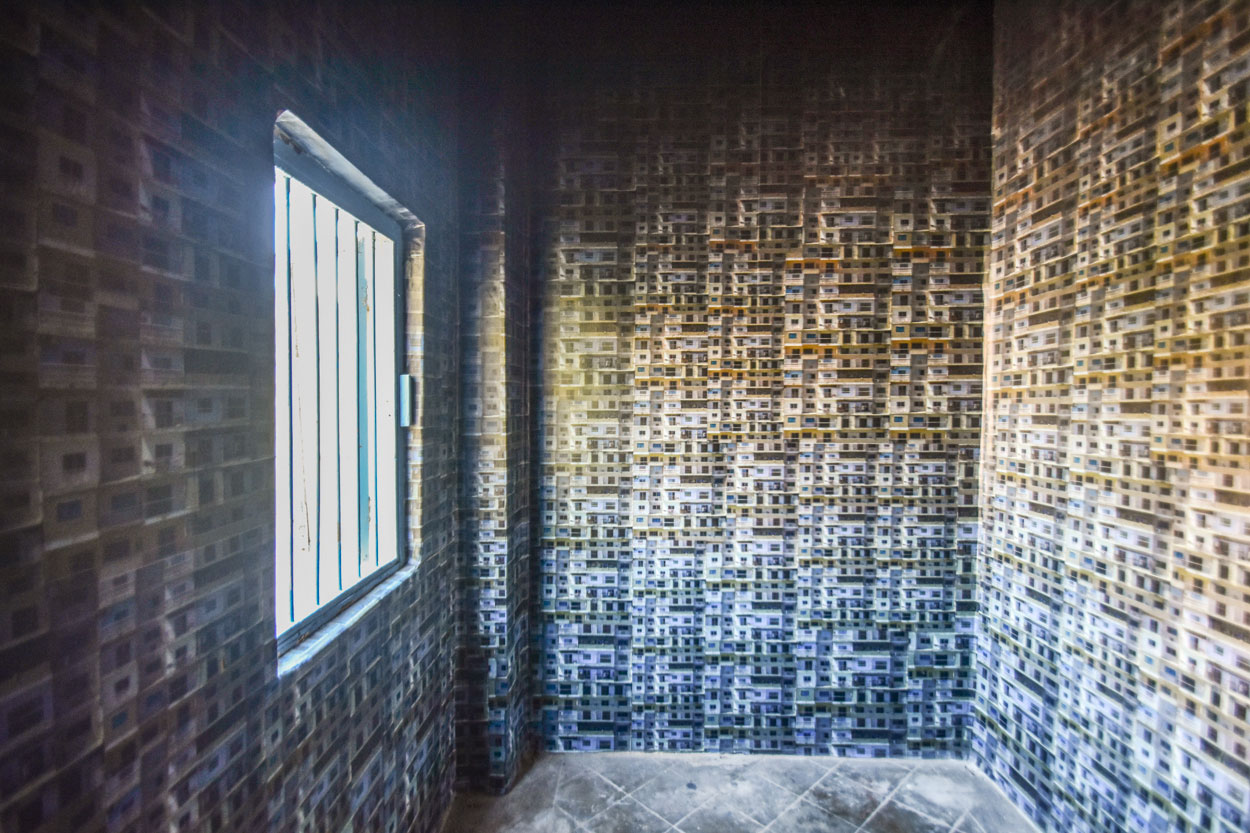
Makaan/Ghar (House/Home), 2017.
Mixed media installation
Dimensions variable
Courtesy the artist
Farooque Ali Chandio
Born in 1982 in Dadu (Pakistan)
Lives and works in Gwadar (Pakistan)
Farooque Ali Chandio received his MFA from the Institute of Arts and Design, University of Sindh, Jamshoro in 2007. He is currently a Lecturer in Fine Arts at GDA Public Higher Secondary School in Gwadar.
Chandio writes of his drawing for KB17: “I have used graphite to study the linear intricacy of the traditional straw chaabi used for keeping bread…These baskets convey the importance of nourishment, the primal quest in the circle of life. The tattered edges are symbolic of the natural decay that is an inseparable part of life. Grey areas hug the central disc. These represent shadows – shadows that embody the lingering effects of trauma, stored in memory long after the traumatic event has passed.”

Dabakee, 2017.
Graphite on paper.
131 x 122 cm.
Courtesy the artist
Riccardo Muratori
Born in 1981 in Rimini (Italy)
Lives and works in Venice (Italy)
Trained in Philosophy, Riccardo Muratori’s research focuses on the relationship between the “image” and reality, and on the virtualization process produced by new media and technologies operating at the present stage of advanced capitalism. He studied in Venice at Università Ca’Foscari and in Paris at Paris VIII Saint-Denis and Paris VII Jussieu where he attended a number of seminars held by such prominent figures as Alain Badiou, Jacques Morizot and Jacques Rancière. He graduated in 2006 in Philosophy from Università Ca’ Foscari under the supervision of Umberto Galimberti and Luigi Perissinotto with a dissertation based on Jean Baudrillard’s theories. In his dissertation “Games of Reality and Simulation,” Muratori began to enquire into the “status of the image,” considered - according to linguistic theory - as “signifier” of a “signified” (Saussure). From 2006 to 2009, he attended several courses of Philosophy and Aesthetics held by Giorgio Agamben at the Università IUAV - Faculty of Visual Arts - in Venice. In 2007, stimulated by the study of Phenomenology, he decided to change his research tool embracing at first drawing and then painting. In 2009 he became a teaching assistant (“Drawing” course held by Daniele Bianchi) at Università IUAV - Faculty of Fashion Design (CLADEM) - in Venice. In 2011 he was invited to exhibit his work at the 54th International Art Exhibition “La Biennale di Venezia” at the Italian Pavilion with one of his first pictorial works: The Servant, which was the starting point of a new process intended to produce a psychological theatre of simulacra. Since 2013, he has been Professor of Drawing and Illustration at Università IUAV - Department of Fashion Design, Visual Arts, Theatre in Venice.
Riccardo Muratori writes of his painting on view at KB17: “The female figure, depicted in this painting, could be interpreted as a muse (Aoede), who conceals herself or takes refuge through the instrument which should be the means of proper expression. Her generative force, momentarily suspended, is hidden by melding into her own shadow. The creation of a shield with a guitar is an expression of a phase of latency: does it represent a definitive withdrawal or rather a hiding place from which to launch a decisive attack?”

Girl with Guitar, 2015.
Oil on canvas
152 x 110 cm.
Courtesy the artist
Stephen Sheehan
Born in 1986 in Birkenhead (UK)
Lives and works in Birkenhead (UK)
Stephen Sheehan graduated from Wirral Metropolitan College obtaining a first class honours degree in Fine Art in 2014. In 2016, he obtained an MA in Fine Art at John Moores University at Distinction Level. During his MA, Sheehan was nominated and selected as a Liverpool Biennial Associate Artist, a two-year programme that aims to support and develop the career of northern artists on an international level. Sheehan predominately works with film, performance and video. He has a particular interest in exploring human mortality and repetition.
Sheehan has submitted two videos for the 2017 Karachi Biennale. The first, Parrot Reflection, is a film he created during a one-month residency at ALN in Albany, New York, USA in 2016. Parrot Reflection depicts the moment when a character wearing a hat (played by Sheehan) discovers his reflection in a mirror that he finds in the snow. The film then proceeds to capture various characters as they find themselves in questioning conversations with their own physical reflections within an absurd world. Sheehan used Averill Park, a hamlet in rural New York, as a backdrop for the film while blending real life situations with filmed performances, allowing both fantasy and reality to merge. The work comments upon existence, morality and the self. The second video, titled Cambrian Explosion: I Arrived at the Circus at Two Minutes Past Eight, is a new film created specifically for KB17 during a one-month residency in Karachi with Vasl Artists’ Association. Making reference to the brief of Sight, Sheehan refers back to the Cambrian Explosion as a foundation for the film. The Cambrian Explosion was a period in time when sight first developed allowing life to flourish. Sheehan transforms and places the Cambrian Explosion into modern day society while exploring and presenting the absurd, beautiful, fragile and transient existence we find ourselves in. Stephen Sheehan will also be doing a performative work for the Karachi Biennale 2017.

Still from Parrot Reflection, 2016.
Single channelled video, 14:22 min.
Courtesy the artist
J&K
Live and work in Berlin (Germany) and Copenhagen (Denmark)
The artist duo J&K are Janne Schäfer (b. 1976 in Darmstadt, Germany) and Kristine Agergaard (b. 1975 near Copenhagen, Denmark). They have been working in collaboration since 1999 and are based in Berlin and Copenhagen, respectively. J&K have had numerous international solo shows and participated in many group exhibitions at, among other places, Mathaf, Doha; Institut du Monde Arabe, Paris; IVAM, Valenica; Museum for Egyptian Art, Munich; Latvian Centre for Contemporary Art, Riga; NGBK+ Kunstraum Kreuzberg, Berlin; Kunsthal Nikolaj, Copenhagen; Galerie im Körnerpark, Berlin; Den Frie Centre of Contemporary Art, Copenhagen and the Liverpool Biennial.
Mammal Matrix (MaMa) is a new video work by J&K created for KB17. The video consists of a looped animation of still photography images showing a colourful and vividly textured composition of bedding materials, fabrics and objects in constant transformation seen from a bird’s eye view. The painterly scenarios reference death and birth beds, and bear witness to possible rituals and stages of passage that are lived and performed in them. The image sequence is accompanied by spoken text taking the audience on a cosmic journey through multiple states of birth and death, from the edge of the universe into a womb on planet Earth. The protagonists of this journey are a basilosaurus, a chicken, a sesame seed and a meteorite: phenomena that are all loosely referencing the ancient cultural and geological history of the region that makes up today’s Pakistan. Mammal Matrix (MaMa) is offering a zoomed-out perspective on life as a continuous cycle in which being-hood shifts and where the man-made categories and borders between human and animal species, plants, minerals and things are questioned and explored. The work is shown as a projection within a full-floor installation composed from various soft materials allowing the audience to sit or lie down and experience the work as a form of guided meditation on the transient mysteries of life and death. The floor installation partly references the aesthetics of the video and blends it with local materials creating a communal patchwork. Mammal Matrix (MaMa) was created while J&K were personally facing actual birth and dying processes and the artists wish to thank Linards Kulless (production assistance) and Fritz Stollberg (photography and edit) for their great personal and artistic support. Text for the video was written with and spoken by Jonathan Bonnici. The work was realised with financial support from the Danish Arts Foundation.
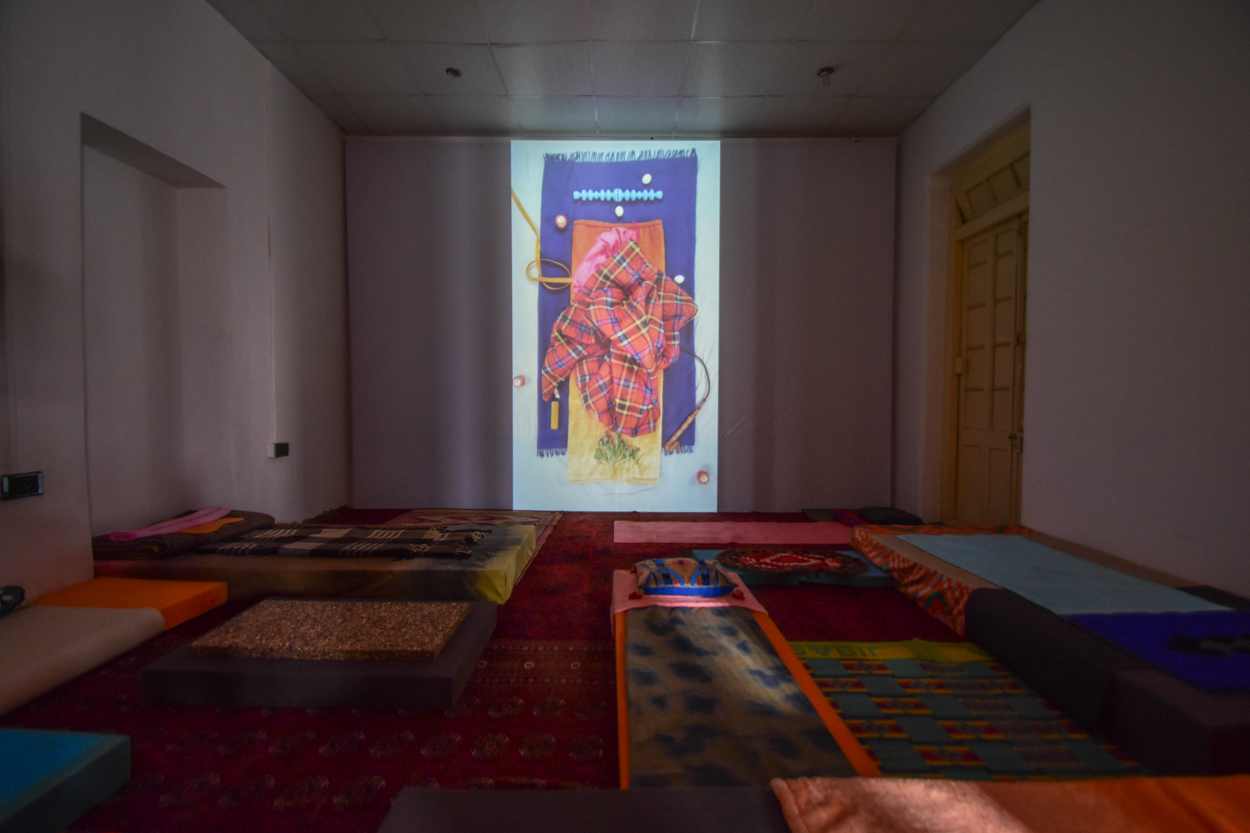
Mammal Matrix (MaMa), 2017.
Video installation, 12:28 min.
Courtesy the artists
Mir Jabal
Born in 1987 in Quetta (Pakistan)
Lives and works in Quetta (Pakistan)
Mir Jabal received his BFA (Painting) from the University of Baluchistan and his MFA from the National College of Arts, Lahore. He currently teaches at the Institute of Art and Design, University of Baluchistan.
Mir Jabal writes of Lives Wasted Away for KB17: “I have been working on paintings based on the theme of our reductive materialist conception of organic life. Exhilarated despair, loss of selfness, moral masochism, sickness and disease are what I find to be its starkest and most relevant expressions. Visually, via the organic texture comprising dots, I have tried to create the microscopic feeling of the cellular structures of biology and human evolution. I have attempted to give expression to the reality of the human condition in its Darwinian, evolutionary sense. To say that our hopes and desires, our loves and hates are nothing other than the activity of flesh and bone, guided by the unhurried dictates of nature puts the individual in a very disturbing situation. The soul, mind and self become merely functions of the body, and nothing else remains; where mystery is to be had, there is mechanism. Indeed, I want to reflect in my paintings human nature in its truthful scientific and biological manifestation. My symbolism is an allusion to the innumerable aspects of our corporeal selves that guide our base nature.”

Lives Wasted Away, 2017.
Oil on canvas
152 x 95 cm.
Courtesy the artist
Imrana Tanveer
Born in 1985 in Sialkot (Pakistan)
Lives and works in Karachi (Pakistan)
Imrana Tanveer is a Karachi-based artist whose work incorporates weaving and textiles, appropriating iconographical images from art and culture to address socio-political issues, both locally and globally. Her multi-medial practice synthesises imagination and reality, extricating a complex visual dialogue which simultaneously deconstructs our collective realities and reconstructs an imagined reality, scrutinising and transmuting the world in which we live. Tanveer holds degrees from the National College of Arts, Lahore, and Textile Institute of Pakistan, Karachi. Having won the International Emerging Artist Award in 2016 in Brussels, Belgium, she is currently one of thirty finalists for the Sovereign Asian Art Prize, and her work has been exhibited throughout the world. Islamic Art Magazine featured Tanveer’s first solo show in its top ten solo and retrospective exhibitions of 2013, and her work is part of highly-acclaimed collections such as that of the British High Commission, Islamabad; the Ierimonti Gallery, USA; and the AAN Collection, Pakistan.
In her work for the Karachi Biennale 2017, Construction/Deconstruction: The Work is Present, Tanveer has reprocessed one of her previous installations, Post Betrayal (2012), in which she applied her textile practice to create a camouflage parachute, using digital mapping to place the work in a series of international galleries and museums, primarily in the United States. Thus, her work wittily comments on the primary aim of many peripheral art practitioners; to have their work exhibited in the Western centers of power in the global art world, by placing one of her previous works in a litany of Western institutions. The work’s satirical commentary on the implications of the North-South axis of power in contemporary art is strengthened by the underlying exploration of the definition of art in the digital age, wherein interactivity and virtual reproduction are a reality, calling for, in the words of Tanveer, “a new conceptual understanding of different techniques, production and display methodologies.”
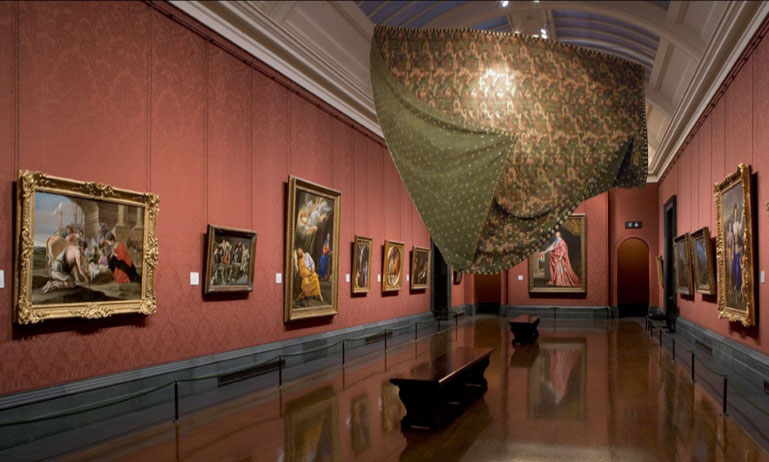
Construction/Deconstruction: The Work is Present, 2017.
Video, 2 min. on loop.
Courtesy the artist
Matilde Marín
Born in 1948 in Buenos Aires (Argentina)
Lives and works in Buenos Aires (Argentina)
Matilde Marín’s work revolves around what she calls “the internal memory of man.” Her current production is focused on the role of the artist as a witness, recorded through photography and video stories about the world we inhabit, situations that relate to pure landscape as well as its natural or artificial alteration. The artist has exhibited widely both in Argentina and internationally. She participated in the 2015 XII Biennial La Habana, Cuba and the XX Biennial de Curitiba, Brazil and received the Biennial Award of Puerto Rico and Bienal de Cuenca, Ecuador. Marín was also bestowed with the Jorge Romero Brest Award by the Argentina Association of Art Critics and the Platinum Konex Award. Her work can be found in the collections of Malba, Museum of Latin American Art, Buenos Aires, Argentina; Bronx Museum of Art, New York, USA; and Contemporary Art Center Reina Sofia, Madrid, Spain.
Adriana Almada has written of the work by Matilde Marín, on view at KB17: “To record images of fumes is to stop the course of history and make all bonfires one. In the same way that Bertolt Brecht extracted from newspapers maps and scenes of the Second World War and mounted them in his Arbeitsjournal (Labor Diary), or as Aby Warburg long before did with his Atlas Mnemosyne, inviting a re-reading of European civilization from a free association of images, Matilde Marín collected (2005-2011) hundreds of photographs of different ’fumes’ -with their respective legends- appearing in the press. To read them is to get an overview of our convulsive times…Smoke is usually the rubric of a catastrophe; the list is endless. The epigraphs change, but the smoke remains. Other and more recent fumes are shown on the move -also confirming the end of an era-, such as the spectacular implosion of Kodak Building 53 (July 18, 2015) -which manufactured the acetate base of photographic film in Kodak Park, Rochester, USA.”
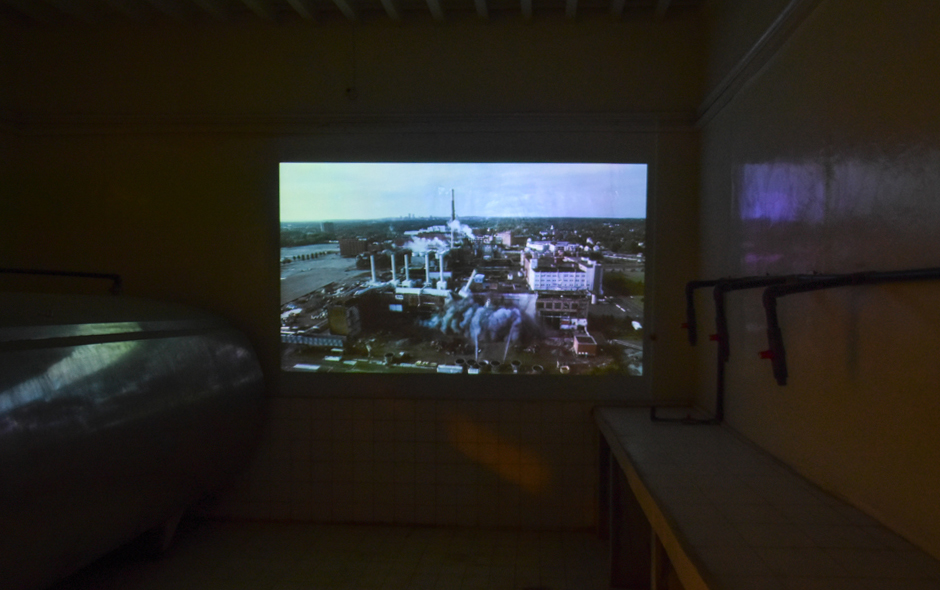
Factory, 2017.
Post production video, 1:00 min.
Courtesy the artist
Umber Majeed
Born in 1989 in New York (USA)
Lives and works between New York and Lahore (Pakistan)
Umber Majeed completed her MFA from Parsons The New School for Design in 2016, having graduated from Beaconhouse National University in Lahore, Pakistan in 2013. Majeed has shown in venues throughout the world, including: The Slought Foundation, Philadelphia; Shirin Gallery, New York; The State Hermitage Museum, St.Petersburg; Queens Museum, New York; and apexart, New York. Her work has been acquired by several private collections, including the Lekha and Anupam Poddar Collection at the Devi Art Foundation in Gurgaon, India, and she recently completed the HWP fellowship at Ashkal Alwan in Beirut, Lebanon. Majeed’s interdisciplinary practice is conceptually driven by physical and cultural displacement; and characterised by multi-cultural experience. As a result, her work is a manifestation of cultural hybridity, engaging with discourses surrounding migration, post-colonial confusion and definitions of political contentiousness. The fragmented perspective conspicuous within Majeed’s drawings, collages, and animations depicts the complexity of cultural identity, and the accompanying burden of misconception.
Atomi Daamaki Wali Mohabbat, Majeed’s work for the Karachi Biennale 2017, is an animation that chronicles the history of nuclear power in Pakistan compiled through national and familial archives. The disjointed and uncomfortable aesthetic perfectly dissects the history of nuclear testing in Pakistan, with Majeed using Chagi Monument Hill as a visual motif within a digital space to constitute a poignant moment in history. She furthers this by utilising flora as a symbolic representation of embedded violence, subverted by the hegemonic narration of a fictitious populist Urdu poet.

Still from Atomi Daamaki Wali Mohabbat (The Atomically Explosive Love), 2017.
Animation, 30 min.
Courtesy the artist
Danial Hyatt
Born in 1991 in Rawalpindi (Pakistan)
Lives and works in Karachi (Pakistan)
Danial Hyatt is a multidisciplinary artist focusing on Music/Sound and Videogames/Programming. His work contains recurring themes of myth and is executed with emphasis on technology. He was awarded an MFA in Creative Practice from Plymouth University (UK) in 2017.
Danial Hyatt writes of Ziggurat of Neglect for KB17: “From the ancient dolmens to Lego, the deliberate act of stacking, connecting and balancing material blocks is embedded in human nature. It can be observed plainly in Karachi, amplified by hues from the setting sun on raw concrete. This manifestation also lives in the garbage heaps that cast long shadows in the junkyard.”
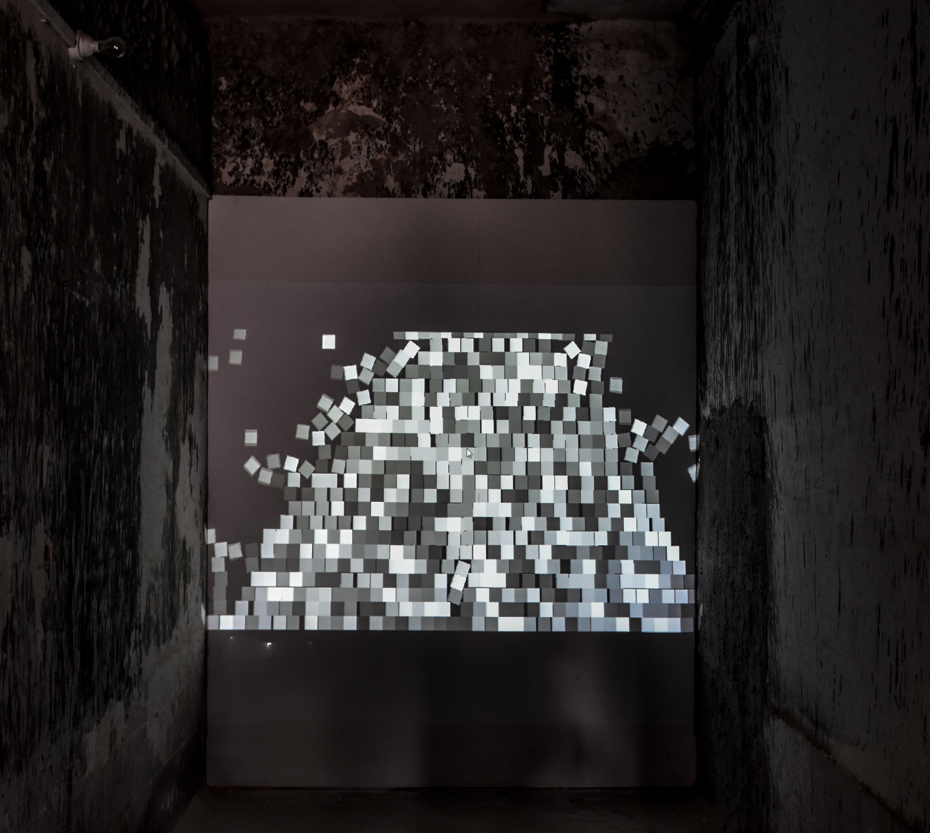
Ziggurat of Neglect, 2017.
Computer program / simulation
Infinite duration
Courtesy the artist
Ayman Oghanna
Born in 1985 in London (UK)
Lives in Athens (Greece) and works throughout the Middle East
Ayman Oghanna is a journalist and photographer who specializes in the Middle East. Half-British, half-Iraqi, he now lives in Greece. After earning an M.A. in International Relations and Middle East Studies from the University of St Andrews, Oghanna worked for The Daily Star newspaper in Lebanon, before leaving to study journalism at Columbia University in New York. He moved to Iraq in 2009 to begin working as a freelance journalist. He has since covered much of the Arab World. His stories, photographs and videos have appeared in many publications, including The New York Times, The Washington Post, The Wall Street Journal, The Guardian, The Sunday Telegraph, Newsweek, National Geographic, VICE and Al Jazeera America. He is proud to be a founding member of the Frontline Freelance Register, dedicated to protecting and uniting freelancers reporting in foreign countries and conflict zones.
Ayman Oghanna writes of his three photographs on view at KB17: “I am exhibiting work from Iraq, where I began my career exploring my father’s country. My father left the country in the 1970s, Asir al Tahabi, the Golden Age. The Iraq I discovered, however, looked very different from the one he left behind, nearly having car-bombed, kidnapped and executed itself into oblivion. I’ve documented the country since the American occupation and Iraq has known little prosperity since, witnessing an endless cycle of violence recently manifesting itself with the rise and fall of the so-called Islamic State. Torn between opposing forces vying for influence in the Middle East, the country remains fragile, flawed and complex. These images offer an insight, however brief, into the country, its pain and its hope. Unfortunately, I do not think it will be truly at peace in my lifetime, however, I will continue to carry on documenting its struggle for a better future and bear witness to its stories.”

Rescue of an Elderly Civilian, 2016.
Photograph
Courtesy of Ayman Oghanna
Althea Thauberger
Born in 1970 in Saskatoon (Canada)
Lives and works in Vancouver (Canada)
Althea Thauberger took degrees in photography and studio arts at Concordia University (2000) and the University of Victoria (2002), and studied media philosophy at the European Graduate School in Saas Fee Switzerland (2009/10). She has taught art and theory in many post secondary institutions including Simon Fraser University, Vancouver; Concordia University, Montreal; and the Art Academy of Prague. She is currently a guest lecturer in the Liberal Arts Program at the Indus Valley School of Art and Architecture in Karachi. Working in photography, film/video and performance, her practice is concerned with collaborative possibilities of the social documentary form. Her recent film projects have involved research and engagement with particular sites and their communities to generate a performance-based narrative. The resulting films reflect on social, political and institutional power relations and present situations in which these dynamics may be challenged or break down. Her screenings and exhibitions include the Audain Gallery, Vancouver; the 2012 Liverpool Biennale; the 17th Biennale of Sydney; La musée d'art contemporain de Montréal; The National Gallery of Canada; The Berkeley Art Museum; Manifesta 7; Overgaden Institute of Contemporary Art, Copenhagen; BAK, basis voor aktuele kunst, Utrecht; The Power Plant, Toronto; and the 3rd Guangzhou Triennale among many others. She is represented by Susan Hobbs Gallery, Toronto.
Althea Thauberger has two works on view at KB17: a photograph entitled “Who is that cane tell me who I am?” and a digital film paired with a painted movie billboard. The film features the built environment of Capri Cinema's modernist architecture and its security modifications, along with a cast of approximately 200 extras. The Capri is one of only two remaining single screen projection houses remaining in Saddar, Karachi's city centre, and it remains a fully functioning cinema despite many difficulties and attacks, including a mob fire attack in 2012. The cast of the film will be drawn from the cinema's existing patrons as well as from the diverse community of residents directly surrounding the site. The scenes are generated through a workshopping process and will relate to the remarkable history of the site.

Pagal Pagal Pagal Pagal Filmy Duniya (Mad Mad Mad Mad Filmy World), 2017.
Digltal film (29:00 min.) and painted billboard (304 x 914 cm.)
Courtesy the artist and Susan Hobbs Gallery, Toronto
Abdullah M.I. Syed
Born in 1974 in Karachi (Pakistan)
Lives and works between Karachi, Sydney (Australia) and New York (USA)
Abdullah M.I. Syed holds a PhD in Art, Media and Design (2015) and a Master of Fine Arts (2009) from the University of New South Wales, Sydney. He also holds a Master of Education (2001) and a Bachelor of Art in Design (1999) from the University of Central Oklahoma (UCO), USA. Syed also coordinated the Department of Design at Karachi University and has lectured at UCO and UNSW Art & Design. Syed’s works have been featured in ten solo exhibitions and several national and international curated group exhibitions and performance events such as Asia TOPA: Asia-Pacific Triennial of Performing Arts, Melbourne (2017), Substitute, Fairfield City Museum and Gallery, Sydney (2016), Between Structure and Matter, Aicon Gallery, New York (2016), 48HR Mass Group Incident, 4A Centre for Contemporary Asian Art, Sydney (2015) and The Rising Tide, Mohatta Palace Museum, Karachi (2010) to name a few. He has also participated in numerous art fairs including Art Central, Hong Kong where he performed The Flying Buck. Syed’s work is also held in many private and public collections notably Devi Art Foundation, AAN collection, Casula Powerhouse and the US Art in Embassy Islamabad. Syed’s awards include the Blacktown Art Prize (2010), the UNSW Postgraduate Research Scholarship (2009) and the IAO Installation Art Award (2003).
Bucking is Abdullah M. I. Syed’s live performance in which he consumes and regurgitates a menu of fresh uncirculated banknotes and addresses the weightiness of the effects of over exerting economical power that no one is immune to. Since first performing the piece in Karachi in 2011, Syed has performed Bucking in multiple cities around the world including Sydney, Australia at 4A Centre for Contemporary Asian Art in 2015. By presenting a video archive of this performance at KB17, Syed pays homage to the performance returning to its place of origin – Karachi, the financial hub of Pakistan. Bucking is a fascinating and at times confrontational look at the central role money plays in economies of consumption and exchange and how money often navigates cultural and political identities and power structures. In the video, the US dollar bill becomes a dominant instrument of addressing complex renderings of the dysfunctions of global market economies, the dissemination of power, and intrinsic neo-colonial concerns. Where the body of the artist is in immediate play, occupied in acts of repetition and endurance, so too is the larger body of the audience, who become witnesses of this seemingly playful but so often violent act.

Still strip from Bucking: Sydney, 2015.
Video documentation of live performance, 15:23 min.
Courtesy the artist and 4A Centre for Contemporary Asian Art, Sydney
Photography: Zan Wimberley
Artist portrait: Mim Stirling
Antonio Puri
Born in 1966 in Chandigarh (India)
Lives and works in Bogota (Colombia)
Antonio Puri was raised in the Himalayas and attended the Academy of Art in San Francisco and Coe College in Iowa for a Bachelor’s in Art and later a JD degree from the University of Iowa. He has had solo exhibitions at Government Museum and Art Gallery, Chandigarh, India; artdepot, Innsbruck, Austria; The Guild Art Gallery, New York; The Loft, Mumbai, India; Nu Art Gallery, Santa Fe; Twelve Gates, Philadelphia; Philadelphia Art Alliance; and a two person show at the Noyes Museum, NJ, USA. He has also participated in numerous group exhibitions. Puri’s expression of the self continuously evolves in an effort to challenge perceptions and deconstruct identifying labels used by others. He is particularly interested in the connections between his Eastern roots and his Western experiences. He embraces the possibility that we can exist in a world free from labels.
Attaching Detaching, Puri’s submission for KB17, comprises of photographs centered upon the insistent gesture of tying the body and face. With this, the artist reflects on the ideological ties that arise due to cultural schemes that relegate us to an existence loaded with paradigms that distort our communion with life and others. In the work, the body becomes a territory invaded by suppositions. In this context, the act of tying emphasizes that we are all prisoners of our circumstances, while the act of untying manifests as a decisive act of freedom. The work alludes to the multiple and often violent ties of the mind and the flesh and our desire to be free of them.

Attaching Detaching, 2017.
Photographic installation
Dimensions variable
Courtesy the artist
James Beckett
Born in 1977 in Harare (Zimbabwe)
Lives and works in Amsterdam (The Netherlands)
James Beckett’s research-based practice explores minor histories, mostly concerned with industrial development (and subsequent demise) across Europe, a process of investigation which is as much physical as it is biographical. Museological display mechanisms are key in Beckett's presentations, with craft-like assembly placing the work uncomfortably between a bourgeois decorative art and a crude social reality. His more recent works focus on the disparate practices of architecture and dentistry and the more metaphysical subculture of dowsing. His recent shows include: T293, IT (2017); 56th Venice Biennale, Belgian Pavilion, IT (2015); 5th Thessaloniki Biennale, GR (2015); Markus Lüttgen Galerie, DE (2015); Wilfried Lentz, NL (2015); Artspace, Aukland/Physics Room, NZ (2014); steirischer herbst, AT (2013); TWAAS, US (2013); Stedelijk Museum, NL (2012); CCA Wattis, US (2012); Dak’art, African Biennale, SG (2012); T293, IT (2011). In 2003 he received the Prix de Rome for art and public space, and has published two monographs: Constant Interjections, TWAAS/Koenig books (2013) and James Beckett, Kehrer Verlag (2009).
James Beckett writes of his installation for KB17: “I would like to connect quite solidly and coherently to the idea of ‘Witness’, but choose not to do so in the most obvious of ways. As a starting point, I intend to look toward the Theatre of the Absurd. In its famous dictum: logical construction and argument gives way to irrational and illogical speech and to its ultimate conclusion, silence. I see potential in such silence, for that too of the witness. Overwhelmed, dumb-struck, numb: a frozen spectator - yet a subject by all means. For Karachi, it is not a theatre piece or a play I will attempt, or even a documentative form for these players, but a research project looking to connect contemporary and historical moments, to find a form or a manifestation of ‘witness’ through the lens of the absurd. At this moment I am looking at the so-called ‘dynmamic back lights’ of Audi A6/A7 sedans. The indicator of these lights is animated, so that LEDs move in sequence in the direction the driver intends driving. It is a kind of over-explained gesture, or sign - a point where technology becomes patronising by over-developing already well functioning systems. I find this to be an appropriate metaphor for the times in which we live. In research I intend to expand on such a collection, to the formation of an installation to be titled Simple Indicators. My resulting work primarily hopes to engage and activate a public in Karachi, but purposefully looks for a more sublime and subliminal fashion. It is in this sense I see this opportunity to show in the Biennial, as a chance for experiment and change.”
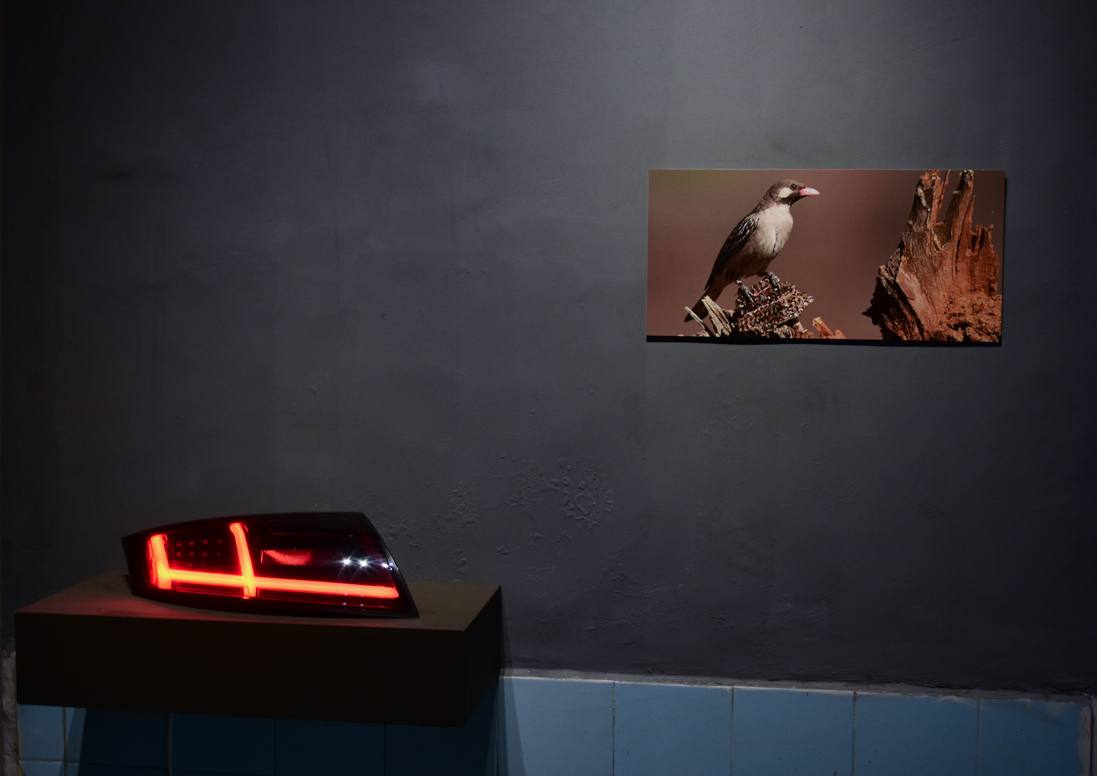
Simple Indicators, 2017.
Mixed media installation
Dimensions variable
Courtesy the artist
Photo of the artist by Janiek Dam
Mahbub Jokhio
Born in 1992 in Mehrabpur (Pakistan)
Lives and works in Lahore (Pakistan)
Mahbub Jokhio graduated with distinction from Beaconhouse National University in Visual Arts as a UMISSA scholar, and currently teaches at the National College of Arts, Lahore.. Utilising a variety of mediums and spanning diverse subject matter, his work hinges on the explicit appropriation and incorporation of conflicting signs, symbols and illusory indexes, drawing into question patterns of perception and intention in their ambiguity. Jokhio’s work has been shown in a variety of exhibitions, at venues including: IVS Gallery, Karachi; TAG, Lahore; Canvas Gallery, Karachi; and Alhamra Art Gallery, Lahore. He was also recently awarded a Gasworks Residency in London.
In Jokhio’s site-specific installation for the Karachi Biennale 2017, Jese Shahr-e-Madfoon Py Waqt Guzray!, the artist has recreated a children’s graveyard, constructing the graves out of mud, bricks and plastered with cement. The vibrant, gaudy colour scheme of the graves belies the sombre subject matter, epitomising Jokhio’s aesthetic discourse between images and their epistemology. The way in which the work’s bright and colourful final manifestation is unable to be separated from the basis of its subject matter, replicating the form of children’s final resting places, visually represents the inseparability of life and death in the human experience. Simultaneously, it analogously comments on the failings of the Pakistani education system, suggesting that the superficial concealment of these flaws does not change the collective realities of the children that it has failed.
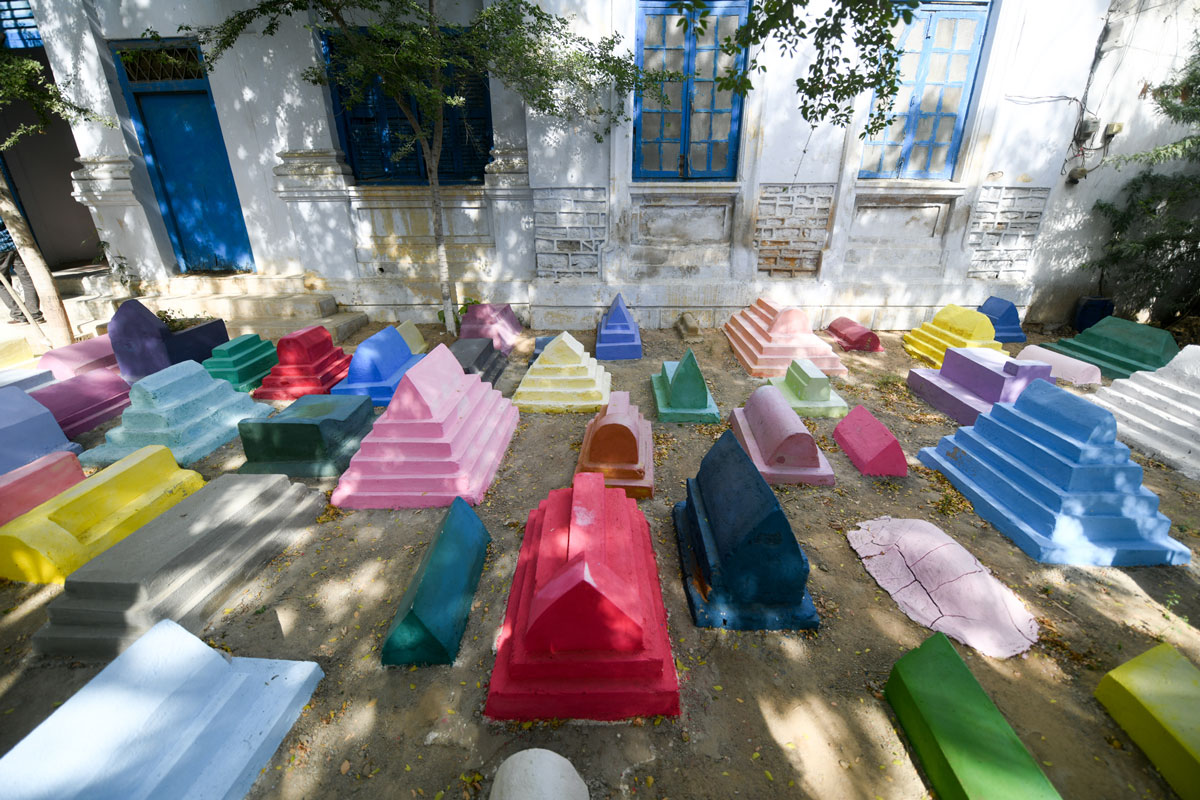
Jese Shahr-e-Madfoon Py Waqt Guzray!, 2017.
Bricks, cement, mud, synthetic enamel and emulsion
Dimensions variable
Collection of the artist
Yasser Vayani/Veera Rustomji/Hira Khan/Ammara Jabbar
Yasser Vayani (b. 1992, Nairobi, Kenya) is a graduate of Indus Valley School of Art and Architecture (IVS), Department of Fine Arts. Some of his selected exhibitions include a site-specific group show, 'Up, Down, Inside and Out' at The Jamshed Memorial School, Karachi, in 2014, ‘Origins’ at VM Art Gallery, Karachi, in 2015, Yasser was also selected to create an installation in Budapest, Hungary for the Sziget Festival in 2015. He recently had his first solo show at the IVS Gallery titled 'Drawing (im)possibilities’, in 2016. He has participated as a resident artist for the Koel Gallery’s January 2017 ‘Open Studio Residency’ and been a resident artist at The Creative Center, Stöðvarfjörður, Iceland, Saari Art Residency, Mynämäki, Finland. Hira Khan (b. 1993, Karachi, Pakistan) is a practicing visual artist and a Research Coordinator at the Vasl Artists’ Association. Hira completed her Bachelor’s degree in Fine Art in 2015 from the Indus Valley School of Art and Architecture, Karachi. She has displayed her work at VM Art Gallery, the Karachi Literature Festival 2016 with Canvas Gallery and at Koel Gallery as part of the Mandarjazail Collective exhibition titled ‘Excerpts’. She was an artist in residence at the Hollows’ Artspace, in New York, USA, 2017. Veera Rustomji (b. 1992, Karachi, Pakistan) is a visual artist and writer based in Karachi, Pakistan. She graduated in 2015 from the Department of Fine Art of the Indus Valley School of Art and Architecture. A recipient of the Rangoonwala Trust Academic Scholarship, she continues to conduct research for her practice that is driven by her interest in the parallel dialogues of migration and heritage. At present, she is working as an assistant coordinator for Vasl Artists’ Association and pursues freelance writing with numerous publications. Veera has displayed her work within Pakistan and was an artist in residence for the 2017 Murree Museum Artists' Residency. Ammara Jabbar (b. 1992, Karachi, Pakistan) is a graduate of the Department of Fine Art of the Indus Valley School of Art and Architecture. She was selected for the Gasworks Residency UK, in 2016 and has displayed her work within Pakistan and the UK. Ammara's interests meander within the aesthetics of dialect and language, in terms of script and the general denominators of masculinity and femininity in the Urdu language.
The artists write of their installation of discarded sofas for KB17: “‘Junk’ is a relative term as it implies the terminal end of an object or a process which cannot be revitalized or has no secondary purpose. We are interested in the personification of these items of furniture using materials found from the site in order to readdress what the human mind categorizes as junk. Art can be seen as an extension of people as all human identities are shaped by the space in which they live and socialize. Past identities are bound to the geographies of multiple places. Found material can be viewed as a common base for expressing and sharing thoughts and ideas about connecting to communities and understanding traditions….we aim to individually bring new purposes to the ‘junkyard’.”
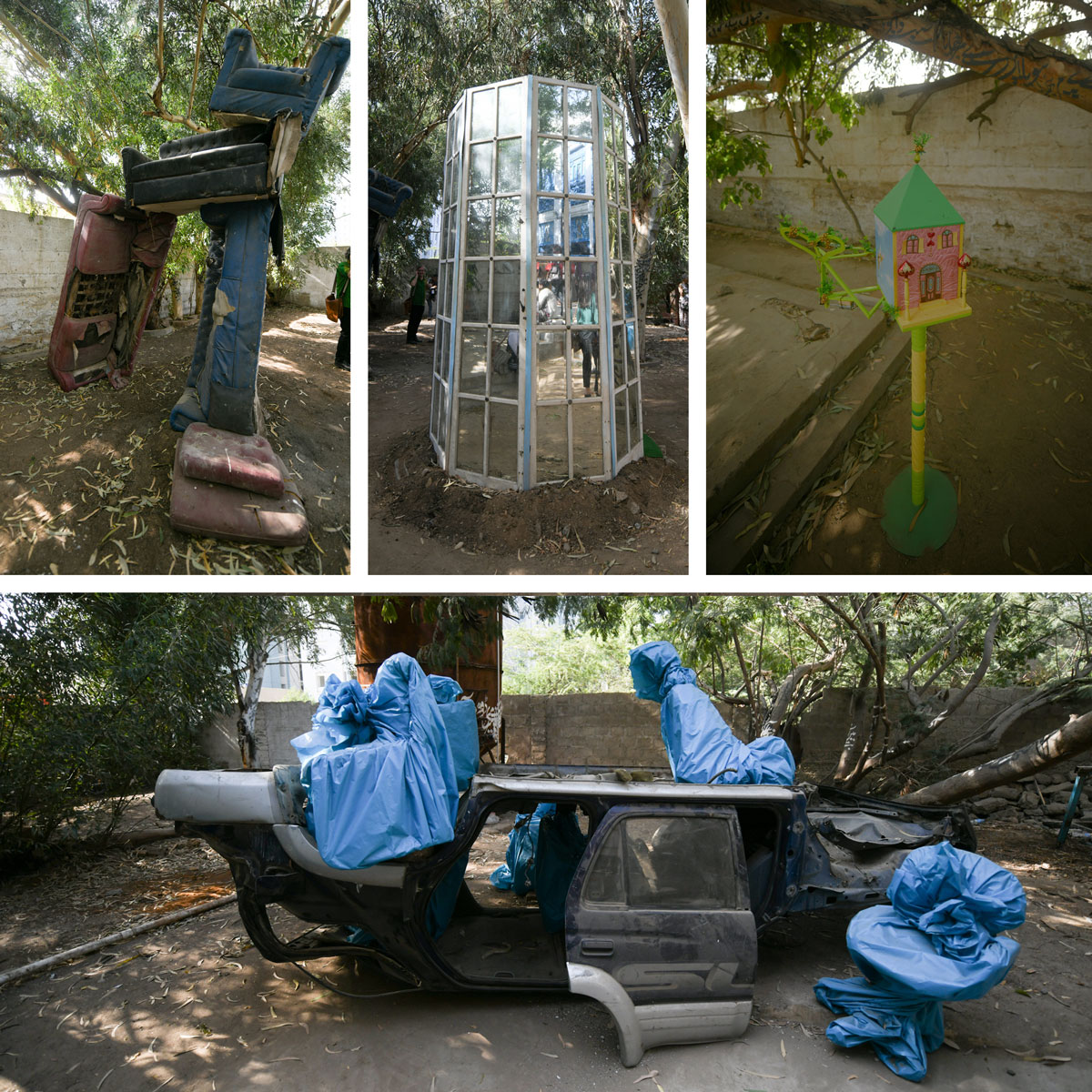
Untitled, 2017.
Installation
Dimensions variable
Courtesy the artists






















